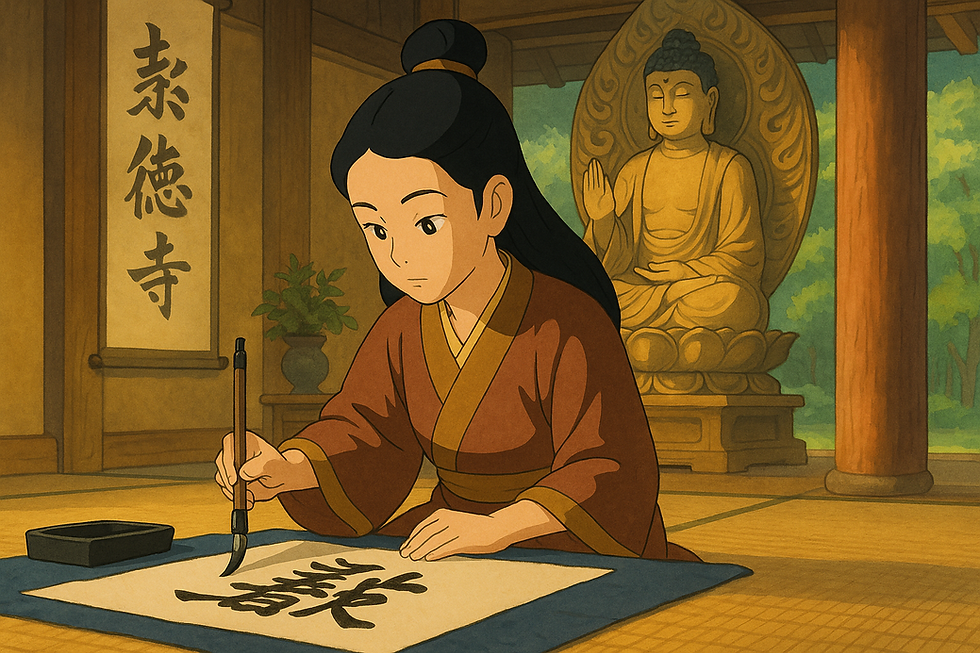Empress Suiko and Japanese Calligraphy — How Buddhist Temples and the Beauty of Writing Nurtured a Culture of Spirit
- 清水 芳樹
- 5月31日
- 読了時間: 3分

Japanese calligraphy is more than the art of beautiful writing — it is a cultural expression of the heart and spirit. One of the most influential figures behind this development was Empress Suiko (554–628), Japan’s first reigning empress. During her reign, Buddhist temples were established across the country, and the practice of sutra copying (shakyō) helped deeply root calligraphy within society. This article explores how temples and calligraphy intertwined to shape Japanese calligraphy into a refined spiritual culture.
Buddhist Temples in the Asuka Period and the Rise of Japanese Calligraphy
The reign of Empress Suiko marked a turning point in Japan’s acceptance of Buddhism. Major temples like Asuka-dera, Hōryū-ji, and Shitennō-ji were constructed during this period. These temples were not only places of worship but also centers of learning, art, and the early development of Japanese calligraphy.
At these temples, monks engaged in the daily practice of sutra copying — not merely as religious devotion, but as a means of spiritual and mental discipline. Writing each character with care became a meditative process, reflecting both prayer and self-cultivation.
The Spiritual Essence of Sutra Copying and Calligraphy
Sutra copying required that each kanji be written with precision and calm focus. A disturbed heart would result in erratic writing; a serene mind would produce balanced, beautiful characters. This belief — that one’s mental state manifests through writing — laid the philosophical groundwork for the aesthetics of Japanese calligraphy.
Sutra copying also served as a training ground for refining one’s calligraphy skills. Monks selected their brushes, ink, and paper with care, striving for elegance in each stroke. Thus, Japanese calligraphy evolved beyond religious practice into a disciplined art form.
Temples as Centers of Culture and Learning
Under the patronage of Empress Suiko, temples became hubs of knowledge and cultural transmission. Monks, scholars, and scribes gathered to exchange techniques and ideas. In addition to religious texts, they copied historical records, poetry, and official documents — laying the literary and artistic foundations of the nation.
The elegant script preserved in these temple archives became treasured cultural artifacts and the earliest examples of Japan’s calligraphic tradition.
The Authority of Calligraphy in Government and Society
During Empress Suiko’s time, all official documents — such as imperial edicts and national laws — were written by brush. These documents demanded not only accuracy but also dignity and aesthetic refinement. Writing was considered an act that demonstrated political power and cultural sophistication.
Calligraphy was thus highly valued in court and government circles. Nobles and monks competed to master the art, and proficiency in calligraphy became a marker of status. As a result, calligraphy became a core element of Japan’s societal structure.
The Spread of Calligraphy Among Women
As a woman herself, Empress Suiko’s reign encouraged the spread of calligraphy among women in the court and temples. Calligraphy and poetry became key components of a woman’s education. This movement led to the later development of kana scripts, female calligraphers, and the flourishing of waka poetry and literary diaries in the Heian period.
Women's expressions and sensitivities greatly expanded the diversity of Japanese calligraphy and gave it a profound cultural richness.
Conclusion: Empress Suiko and the Spirit of Japanese Calligraphy
During Empress Suiko’s reign, calligraphy took root in Japanese society alongside Buddhism, centered in temples throughout the country. Through sutra copying, writing became prayer, discipline, and artistic expression. From official state documents to emotionally expressive letters, calligraphy developed into a multifaceted cultural practice.
Even today, Japanese calligraphy carries the legacy of Empress Suiko’s time — the tradition of writing with heart, investing beauty and spirit into each character.To learn Japanese calligraphy is to experience stillness, focus, joy in self-expression, and the profound depth of Japanese culture itself.
Experience authentic Japanese calligraphy:



Comments